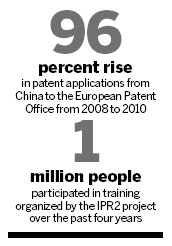Four-year EU program boosts IPR enforcement
Updated: 2011-07-20 13:14
By Wang Xin and Wang Zheng (China Daily)
|
|||||||||||
BEIJING - The nearly 13,000 filings received from China by the European Patent Office (EPO) last year was an increase of 54 percent over 2009 and an "astounding" 96 percent surge over 2008, according to EPO Vice-President Raimund Lutz.
Lutz attributed the growth to increased cooperation between China and the European Union, and the national intellectual property (IP) strategy unveiled in 2008 that shows the Chinese government's "reinforced effort to shift the trade from products made in China to technologies developed in China".
 |
The initiative - known as the IPR2 project - followed a first phase from 1999 to 2004 that promoted international standards in Chinese legislation.
IPR2 began in 2007 with about 16. 3 million euros ($23 million) in joint funding from the EU and Chinese governments. It will conclude in September.
"When looking at IPR2's significance, we see a milestone in the EU-China partnership," said Carmen Cano, minister counselor of the EU delegation to China and Mongolia.
"Enhancing an IPR-friendly environment in China that guarantees fair competition between Chinese and European industries will have a beneficial effect for both economies," she noted.
The EU is China's largest trading partner and the top source of technology imports into the country, according to data from the Ministry of Commerce.
Bilateral trade surpassed $479 billion in 2010, up 31.8 percent from 2009.
Nearly 1,700 new European-funded companies were established in China last year with a combined investment value of $6.58 billion.
Commitment
Lutz cited the Chinese government's commitment to IPR protection as a "fundamental element" to realizing the benefits of the IPR2 project.
"This commitment has been evident through the engagement of all authorities in the implementation of programs," he said.
More than 200 technical assistance and training efforts have been mounted across China since 2007 "over a great diversity of IP fields" to improve the reliability, efficiency and accessibility of the IP protection system in the country, he noted.
"Such results would not have been possible without the very close and fruitful cooperation between all partners involved," Lutz said.
The number of criminal cases settled by courts across China and those convicted for IP violations over the past four years grew by double digits, illustrating the improved capacity to fight infringement, said Wu Handong, professor of law and also president of the Zhongnan University of Economics and Law.
"It is a result of systematic and intense training of enforcement staff," Wu said. More than a million people participated in training organized by the IPR2 project.
The effort provided the governments and industries of China and the EU to exchange opinions and share information on IP issues over a broad range, which will "no doubt have a far-reaching influence on China's IP protection", he said.
 |
Li Mingde, director of the Intellectual Property Center at the Chinese Academy of Social Sciences, said some European expert opinions have been adopted in China's revised laws and administrative regulations, as well as in judicial interpretations by the Supreme Court that instruct judges how to apply laws and provide guidelines for rulings by lower courts.
China's IP legal framework has been influenced by the United States, Japan and the EU.
Yet "before the joint project, EU's influence seemed limited" compared to other regions, Li said.
Revision of cornerstone laws in the IPR framework began in 2006, with the latest taking force in 2009.
The trademark law underwent its third revision in 2003, with yet another draft now on the table at the State Council's Legislative Affairs Office.
European experts offered advice for consideration by Chinese policymakers and legislators, said Andrea Di Carlo, deputy director of the Office for Harmonisation in the Internal Market, which is responsible for providing European trademark and design expertise to the joint project.
His team explained how unconventional trademarks such as colors and sounds are protected in Europe and the reason for protecting them, which partly prompted a proposed change in the law now under revision.
Providing information on common market practices to facilitate the protection of rights is also one of his office's goals , Carlo said.
Carlo Pandolfi, IPR2 technical assistance team leader, said both Chinese and European companies have benefited from the project, as it tried to create a similar business environment.
"Companies go different places, yet want to do business in the same way," he said, so a huge difference could deter investment or trade.
"We hope to harmonize protection systems (in various economies) and create a level field for companies."
Pandolfi said two important IT tools developed by the IPR2 project - a database with free access to legal references on IPR protection in the EU and China, and an online library of training materials contributed by Chinese and European experts - will be handed over to an IT center affiliated with the Ministry of Commerce after the project.